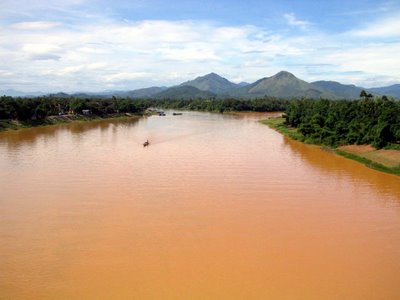 Nope, that isn't in the Philippines. It's a photo of the Perfume River (Huong Giang) in Hue, Viet Nam which I took way back in June 2004.
Nope, that isn't in the Philippines. It's a photo of the Perfume River (Huong Giang) in Hue, Viet Nam which I took way back in June 2004.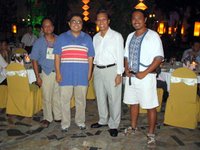 I was looking through some old files to prepare a module on heritage conservation for local government units and saw a copy of the Hue Declaration on Cultural Tourism and Poverty Alleviation. It's quite significant to me not just because of its content but because I was there in Hue at the very time the Asian ministers of tourism were meeting to draft this declaration. I was lucky enough to participate and listen to the ongoing Ministerial Conference thanks to then Tourism secretary Obet Pagdanganan.
I was looking through some old files to prepare a module on heritage conservation for local government units and saw a copy of the Hue Declaration on Cultural Tourism and Poverty Alleviation. It's quite significant to me not just because of its content but because I was there in Hue at the very time the Asian ministers of tourism were meeting to draft this declaration. I was lucky enough to participate and listen to the ongoing Ministerial Conference thanks to then Tourism secretary Obet Pagdanganan. I consider this trip my first backpack adventure. In fact, it was during this 2004 visit to Viet Nam that I bought the very backpack which started my fancy for backpacking. I’ll share the funny story in the next entry. The trip was just for a few days and it should have been longer since I and sculptors Toym Imao and Norman Tiotuico were planning it for quite a while to attend Festival Hue 2004 and the 3rd International Sculpture Symposium which I wanted to duplicate here in the country. But my MBA studies started quite early and I had to cut the trip short so as not to miss too much in class.
I consider this trip my first backpack adventure. In fact, it was during this 2004 visit to Viet Nam that I bought the very backpack which started my fancy for backpacking. I’ll share the funny story in the next entry. The trip was just for a few days and it should have been longer since I and sculptors Toym Imao and Norman Tiotuico were planning it for quite a while to attend Festival Hue 2004 and the 3rd International Sculpture Symposium which I wanted to duplicate here in the country. But my MBA studies started quite early and I had to cut the trip short so as not to miss too much in class.From Manila, I took a flight to Ho Chi Minh City where I stayed for a few hours in transit en route to Hue. I had been to Ho Chi Minh in 2002 during the Ship for Southeast Asian Youth Program so I decided not to stopover anymore since I was pressed for time and I wanted to see new places. The flight to Hue was just an hour. You could opt to take a bus but that would take forever and should be reserved for a trip with lots of time to spare.
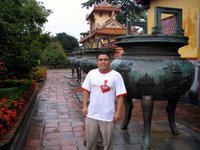 Hue, the former royal capital of Viet Nam's Nguyen Dynasty, is a UNESCO World Heritage Site. Replete with palaces, temples, royal tombs and other remnants of Viet Nam’s rich past, Hue finds itself in the company of other former royal capitals in Southeast Asia which have continuously aimed to preserve their outstanding architectural heritage. These include Angkor in Cambodia, Ayutthaya and Sukhothai in Thailand and Luang Prabang in Laos among others. In fact, the Purple Forbidden City in the heart of Hue was said to be patterned after the one in Beijing.
Hue, the former royal capital of Viet Nam's Nguyen Dynasty, is a UNESCO World Heritage Site. Replete with palaces, temples, royal tombs and other remnants of Viet Nam’s rich past, Hue finds itself in the company of other former royal capitals in Southeast Asia which have continuously aimed to preserve their outstanding architectural heritage. These include Angkor in Cambodia, Ayutthaya and Sukhothai in Thailand and Luang Prabang in Laos among others. In fact, the Purple Forbidden City in the heart of Hue was said to be patterned after the one in Beijing.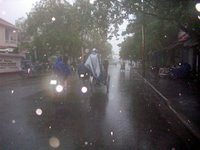 For the most part of the trip, it was raining. In fact, it is said that, "Hue's weather is infamously bad: the Truong Son Mountains just to the south seem to bottle up all the moisture, so it's usually misty, drizzly or outright rainy, and things get even drippier than usual in the winter rainy season. Bring along an umbrella any time of year." So I was always soaked from the torrential rains since our main means of transportation around were bicycles which we rented for the duration of the trip as well as cyclos which were pedicabs with the passengers in front of the biker.
For the most part of the trip, it was raining. In fact, it is said that, "Hue's weather is infamously bad: the Truong Son Mountains just to the south seem to bottle up all the moisture, so it's usually misty, drizzly or outright rainy, and things get even drippier than usual in the winter rainy season. Bring along an umbrella any time of year." So I was always soaked from the torrential rains since our main means of transportation around were bicycles which we rented for the duration of the trip as well as cyclos which were pedicabs with the passengers in front of the biker.Every two years, the city is alive and bustling thanks to a cultural festival called Festival Hue which attracts thousands of people from all over the country. I was impressed at how the Vietnamese value this celebration which featured various aspects of Vietnamese culture. Most Filipinos today would not “waste” their time watching cultural shows and presentations. I guess things that make us Filipino do not matter to most of us nowadays.
 In fact, many of the events at the festival were free. And while I was walking around in the rain, I was lucky to chance upon this concert of an orchestra from Hanoi in one of the old art deco theaters. You just entered and sat down in the hall. I hope we have government-sponsored cultural festivals like these here in the country. It makes me feel sad that we demolish our old theaters here in Manila as well.
In fact, many of the events at the festival were free. And while I was walking around in the rain, I was lucky to chance upon this concert of an orchestra from Hanoi in one of the old art deco theaters. You just entered and sat down in the hall. I hope we have government-sponsored cultural festivals like these here in the country. It makes me feel sad that we demolish our old theaters here in Manila as well.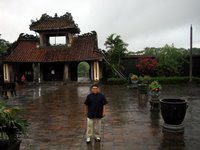 I got to visit the Citadel and the Forbidden Purple City, as well as the tomb of Tự Đức (right) during my first few days. But since it was raining, I didn't get to enjoy the structures as much as I should have.
I got to visit the Citadel and the Forbidden Purple City, as well as the tomb of Tự Đức (right) during my first few days. But since it was raining, I didn't get to enjoy the structures as much as I should have.Food there is cheap and one of my personal favorites was the Bánh Mì Thịt, a Vietnamese submarine sandwich made with a French baguette containing paté, Vietnamese mayo, different selections of Vietnamese cold cuts and deli, pickled daikon and carrots, and cucumber slices, often garnished with coriander and black pepper. These sandwiches are "common everywhere in Vietnam as a favorite of factory workers and school kids and eaten for any meal of the day, commonly breakfast and lunch." There was one stand outside our hotel which sold sandwiches for VND6,000 each (US$1 = 15,000 dong) so I made it a point to try a different one every morning.
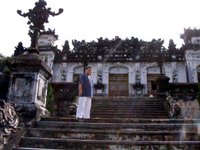 I was lucky that during my last day, it stopped raining. So I contracted the services of a motorcycle-taxi who took me around the various royal tombs that lined the Perfume River. The tombs were lavish, housed in vast complexes along the banks of the river. But visiting them and other ticketed attractions was quite expensive if you planned to drop by many of them.
I was lucky that during my last day, it stopped raining. So I contracted the services of a motorcycle-taxi who took me around the various royal tombs that lined the Perfume River. The tombs were lavish, housed in vast complexes along the banks of the river. But visiting them and other ticketed attractions was quite expensive if you planned to drop by many of them.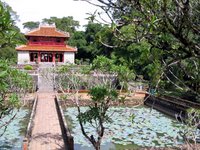 Unlike Angkor which sold passes that allowed you to enter all the sites (Cambodians entered free while tourists paid $20 for a day pass which was still quite expensive), in Hue, each site had its own ticket which would have been perfectly alright if not for the rates.
Unlike Angkor which sold passes that allowed you to enter all the sites (Cambodians entered free while tourists paid $20 for a day pass which was still quite expensive), in Hue, each site had its own ticket which would have been perfectly alright if not for the rates.With the UNESCO World Heritage status, the government really took advantage of this by charging high rates for tourists to enter each one! Vietnamese nationals paid much lower rates while I think I paid VND55,000 (that's US$4) for every tomb I entered. There are eight of them if you have the time and money to visit all. Anyway, at least the fees here are channeled to restoration and not politicians’ pockets.
 For the last day, I visited two more tombs namely those of Khải Định (above left) and Minh Mạng (above right) as well as the Thiên Mụ Pagoda (left). Anyway, you can check out my Patrimoine Mondial album to see more photos.
For the last day, I visited two more tombs namely those of Khải Định (above left) and Minh Mạng (above right) as well as the Thiên Mụ Pagoda (left). Anyway, you can check out my Patrimoine Mondial album to see more photos.OT: To all those generations of kids like myself who grew up learning about the nine planets of the solar system (I was an astronomy buff way back in grade school and had a monthly dose of Astronomy Magazine delivered to my home), Pluto is no longer a planet! Check out the details here.

Ahhh, the joy of backpacking!
ReplyDeleteSO, you ended up getting the travel bug too! I'm glad you learned a lot from it and that you're using what you've seen out there to improve the cultural heritage in the Philippines.
I had enjoyed this opportunity during my university studies just like you. Wish I was still a student since there were plenty of advantages. Backpacking in Europe allowed me to see museums, churches, castles for free or at a discount!
Unfortunately, Asian countries ended up quite expensive for Westerners particularly students. There are no trains or planes that would give you a package to travel throughout an Asian country (like EuRail pass or BritRail pass). I believe Japan offers it but it's astronomically expensive!
Dacal a salamat for the link regarding the Pampanga MTV.
And if you happen to be in the states, let me know.
Hi John, there are now convenient air-conditioned buses which take you from city to city in all ASEAN countries in continental Asia except Myanmar. This is why you can now find the American or European tourist even in the most remote town of Southeast Asia. The Philippines is indeed left behind unless we could offer a cheap means of travel from continental Southeast Asia to our major cities.
ReplyDelete